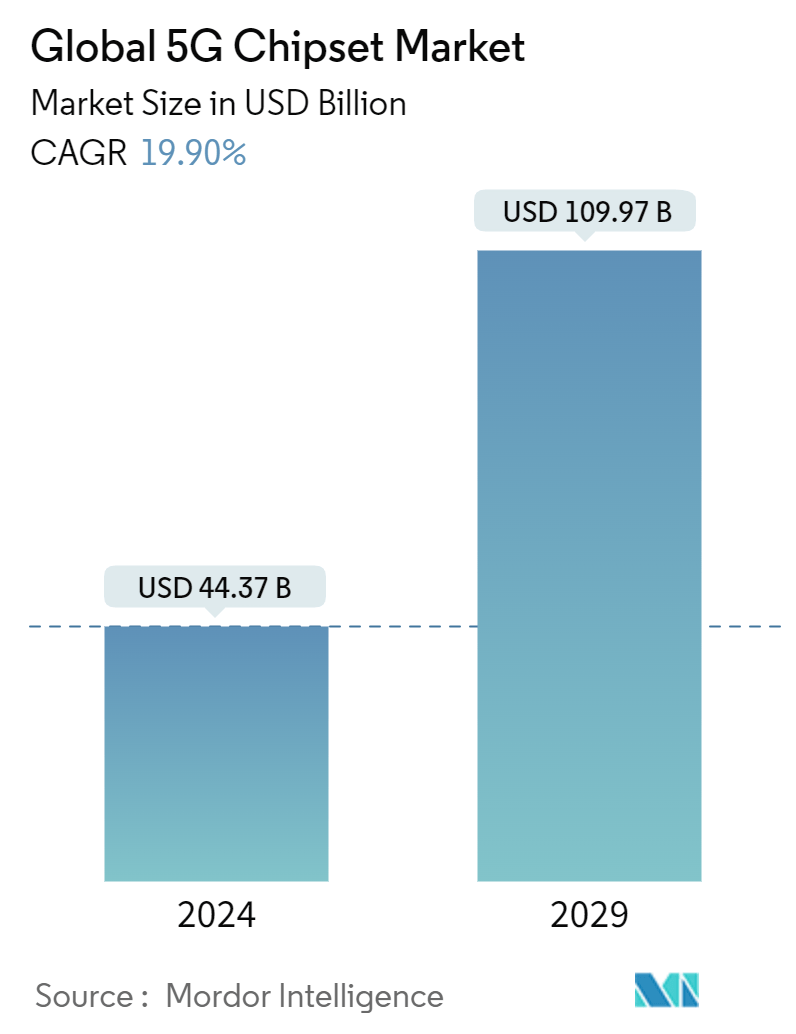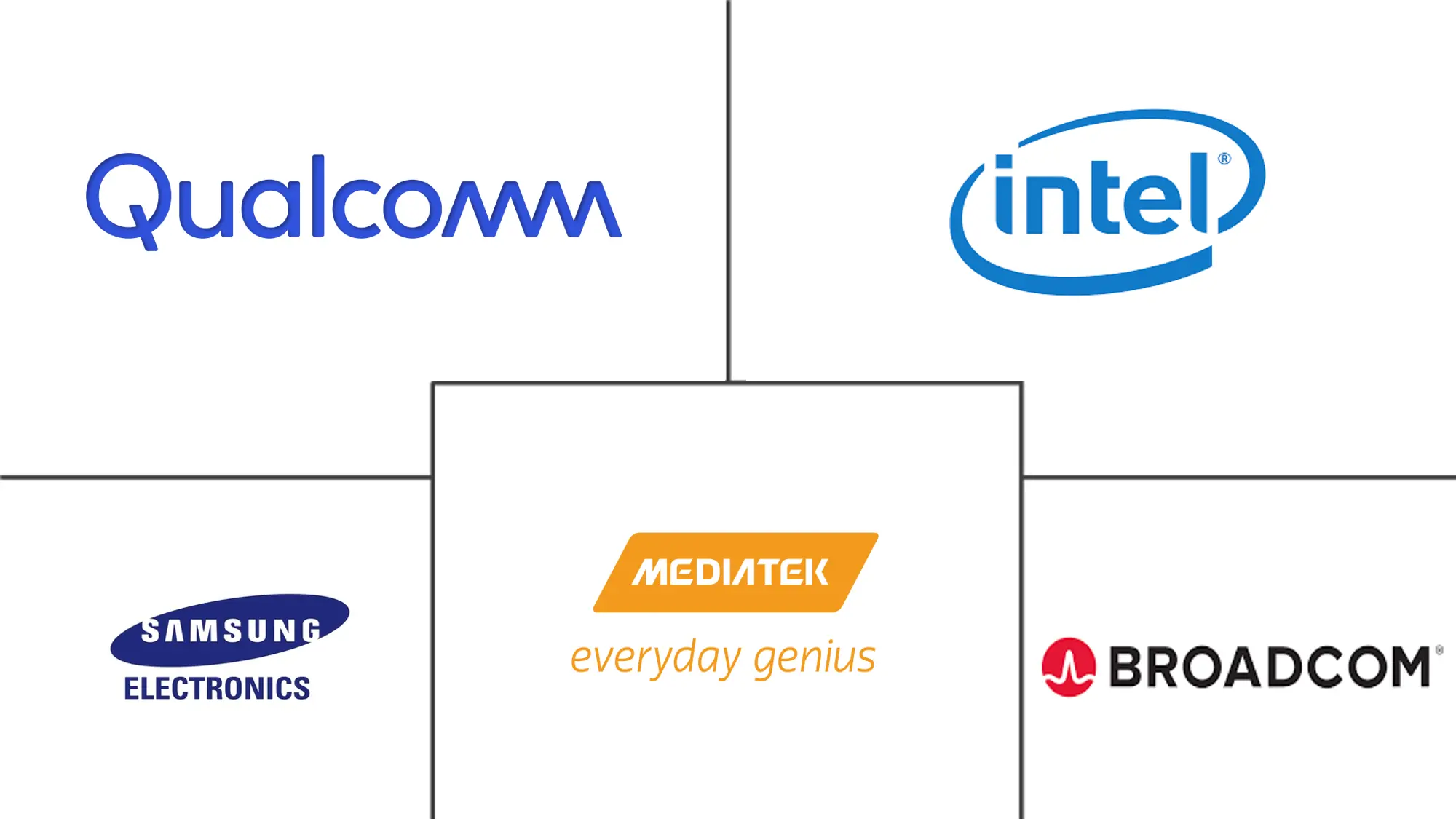Market Size of Global 5G Chipset Industry

| Study Period | 2019 - 2029 |
| Market Size (2024) | USD 44.37 Billion |
| Market Size (2029) | USD 109.97 Billion |
| CAGR (2024 - 2029) | 19.90 % |
| Fastest Growing Market | Asia Pacific |
| Largest Market | North America |
| Market Concentration | Medium |
Major Players
*Disclaimer: Major Players sorted in no particular order |
5G Chipset Market Analysis
The Global 5G Chipset Market size is estimated at USD 44.37 billion in 2024, and is expected to reach USD 109.97 billion by 2029, growing at a CAGR of 19.90% during the forecast period (2024-2029).
The 5G modem chipsets, in combination with service providers, largely serve and enhance the capabilities of three major applications - enhanced mobile broadband, ultra-reliable and low latency communications, and massive machine-type communications. The applications of this technology are expected to drive the demand for 5G chipsets during the forecast period.
- The 5G chipsets are expected to be a critical component of 5G networks, which will soon be rolled out at a massive scale for smartphone OEMs and telecom players. In order to provide ultra-high network speeds and data rates, major telecom service providers across the globe are upgrading their networks to 5G.
- The emergence of 5G is expected to expedite the use of connected devices in industries that are already pushing toward the fourth industrial revolution (Industry 4.0). Industry 4.0 is aiding cellular connectivity throughout the industry; the rise of IoT and machine-to-machine connections is also instrumental in driving market traction. Several smart city projects and initiatives are underway around the world, and it is expected that by 2025, there will be around 30 global smart cities, with half of these located in North America and Europe. These steps are supported by global investments, which, according to the OECD, are expected to total USD 1.8 trillion in urban infrastructure projects between 2010 and 2030. This is one of the major factors driving demand for 5G chipsets, owing primarily to their use in smart city connectivity applications.
- Multiple telecom operators are acquiring spectrums to increase their 5G connection coverage. For instance, in August 2022, In India's first 5G spectrum auction, Airtel paid Rs 43,084 crore for 19,800 MHz spectrum. In the past 20 years, spectrum bands 900 MHz, 2100 MHz, 1800 MHz, 3300 MHz, and 26 GHz have been acquired through auctions. It obtained a pan-India footprint in the 3.5 GHz and 26 GHz bands. According to the company, this is the ideal spectrum bank for the best 5G experience, with 100x capacity enhancement done strategically at the lowest cost.
- During the pandemic, the WFH setting was prepared for the extra technological benefits of 5G: in the Global Workplace Analytics (2020) survey, more than 80% of respondents stated that they had the technical skills and knowledge required for WFH, as well as easy and reliable access to company networks (presumably by both fixed-line and mobile means).
- 3GPP has specified that 5G should offer voice or video communication services based on the IMS, i.e., the IMS must be deployed for 5G-to-3G SRVCC in 3GPP Release 16 or VoNR, EPS FB, VoeLTE, and RAT FB in 3GPP Release 15. Hence such upgrades are expected to increase the infrastructure cost, thereby challenging the market's growth. While every architecture has specific challenges, all of them need network readiness of the IP Multimedia Subsystem (IMS) within the carrier's network.
5G Chipset Industry Segmentation
5G chipsets enable 5G packet transmission on smartphones, portable hotspots, IoT devices, and, increasingly, notebook PCs with mobile network capabilities. 5G mobile devices will combine familiar sub-6GHz bands with new MIMO antenna systems and high-frequency millimeter-wave (mmWave) bands with highly focused beam-steering.
The global 5g chipset market is segmented by chipset type (application-specific integrated circuits (ASIC), radio frequency integrated circuit (RFIC), millimeter wave technology chips, field-programmable gate array (FPGA)), operational frequency (sub-6 GHZ, between 26 and 39 GHz, and above 39 GHz), end user (consumer electronics, industrial automation, automotive and transportation, energy and utilities, healthcare, and retail), and geography(North America, Europe, Asia-Pacific, Middle-East and Africa and Latin America). The report offers the market size in value terms in (USD) for all the segments mentioned above.
| By Chipset Type | |
| Application-specific Integrated Circuits (ASIC) | |
| Radio Frequency Integrated Circuit (RFIC) | |
| Millimeter Wave Technology Chips | |
| Field-programmable Gate Array (FPGA) |
| By Operational Frequency | |
| Sub-6 GHz | |
| Between 26 and 39 GHz | |
| Above 39 GHz |
| By End User | |
| Consumer Electronics | |
| Industrial Automation | |
| Automotive and Transportation | |
| Energy and Utilities | |
| Healthcare | |
| Retail | |
| Other End Users |
| By Geography | |
| North America | |
| Europe | |
| Asia Pacific | |
| Latin America | |
| Middle East and Africa |
Global 5G Chipset Market Size Summary
The 5G chipset market is poised for significant growth, driven by the increasing demand for enhanced mobile broadband, ultra-reliable low latency communications, and massive machine-type communications. As telecom service providers globally upgrade their networks to 5G, these chipsets are becoming critical components in delivering ultra-high network speeds and data rates. The rollout of 5G networks is expected to accelerate the adoption of connected devices, particularly in industries advancing towards Industry 4.0. This technological shift is further supported by the rise of IoT and machine-to-machine connections, which are instrumental in driving market traction. Smart city initiatives and global investments in urban infrastructure are also contributing to the demand for 5G chipsets, as they play a crucial role in connectivity applications.
North America is a key region for market growth, with the United States leading in the adoption of IoT, M2M communications, and mobile broadband applications. The region's telecom operators are actively pursuing 5G rollouts and network transformation strategies, with significant partnerships and innovations in chipset technology. The market is semi-consolidated, with major players like Intel, Qualcomm, and MediaTek driving innovation through strategic collaborations and new product offerings. These developments are enabling new applications, such as V2X communications, which benefit from 5G's enhanced throughput and reduced latency. As the market evolves, the focus on smart manufacturing and digital transformation in various sectors continues to influence the adoption and integration of 5G chipsets.
Global 5G Chipset Market Size - Table of Contents
-
1. MARKET INSIGHTS
-
1.1 Market Overview
-
1.2 Industry Value Chain Analysis
-
1.3 Industry Attractiveness - Porter's Five Forces Analysis
-
1.3.1 Bargaining Power of Suppliers
-
1.3.2 Bargaining Power of Buyers
-
1.3.3 Threat of New Entrants
-
1.3.4 Threat of Substitutes
-
1.3.5 Intensity of Competitive Rivalry
-
-
1.4 Technology Snapshot
-
1.5 Impact of Macro Economic trends on the Industry
-
-
2. MARKET SEGMENTATION
-
2.1 By Chipset Type
-
2.1.1 Application-specific Integrated Circuits (ASIC)
-
2.1.2 Radio Frequency Integrated Circuit (RFIC)
-
2.1.3 Millimeter Wave Technology Chips
-
2.1.4 Field-programmable Gate Array (FPGA)
-
-
2.2 By Operational Frequency
-
2.2.1 Sub-6 GHz
-
2.2.2 Between 26 and 39 GHz
-
2.2.3 Above 39 GHz
-
-
2.3 By End User
-
2.3.1 Consumer Electronics
-
2.3.2 Industrial Automation
-
2.3.3 Automotive and Transportation
-
2.3.4 Energy and Utilities
-
2.3.5 Healthcare
-
2.3.6 Retail
-
2.3.7 Other End Users
-
-
2.4 By Geography
-
2.4.1 North America
-
2.4.2 Europe
-
2.4.3 Asia Pacific
-
2.4.4 Latin America
-
2.4.5 Middle East and Africa
-
-
Global 5G Chipset Market Size FAQs
How big is the Global 5G Chipset Market?
The Global 5G Chipset Market size is expected to reach USD 44.37 billion in 2024 and grow at a CAGR of 19.90% to reach USD 109.97 billion by 2029.
What is the current Global 5G Chipset Market size?
In 2024, the Global 5G Chipset Market size is expected to reach USD 44.37 billion.

